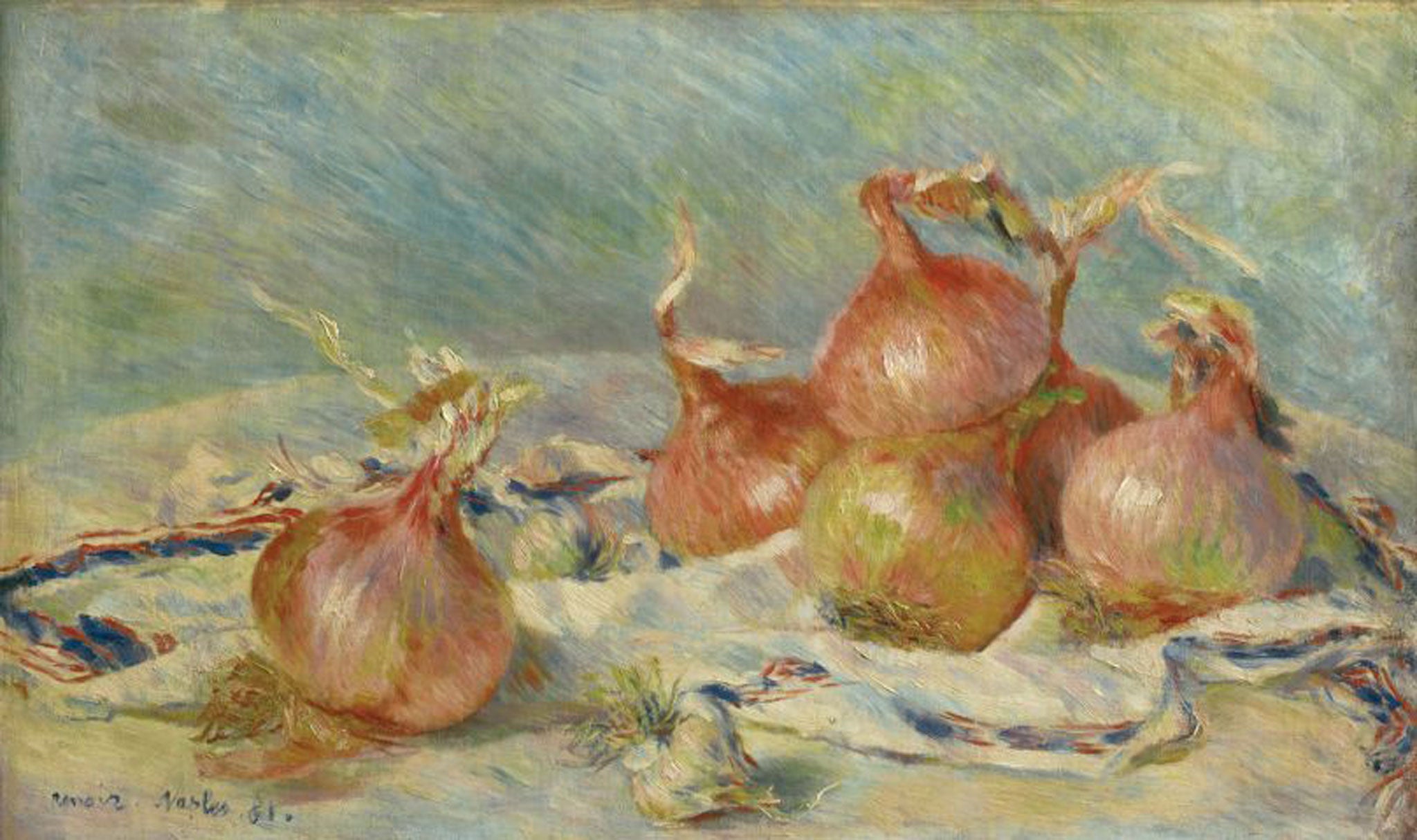Great works: Onions (1881) by Pierre-Auguste Renoir
Kimbell Art Museum, Texas

It is such a relief to chance upon a painting by Pierre-Auguste Renoir that we can enjoy quite so unreservedly. His females, nude or clothed, are often so glutted with sweet fleshiness. To see them, and especially when one scrutinises them in quantity, is a little like imbibing a jeroboam of undiluted cherry syrup.
This painting was bought by Sterling and Francine Clark of Chicago in 1922, and of the far too many paintings by Renoir acquired by those great American collectors of Impressionism, it was their absolute favourite. Surprising? Yes. To a degree, it possesses un-Renoir-like qualities. It seems, in the ever-on-the-move, slightly precarious arrangement of its forms, to display a rather uncharacteristic wit and lightsomeness. It could not be more different from Peonies, for example, another still life bought by those same collectors, which was painted just months before this one. Peonies heaves with the weight of the presence of the flowers. They positively flood the eye. It is all rather wonderful in its way. It is also too much with us. Hold back! we find ourselves wanting to shout out loud.
Peonies, though mere flowers, were rather special ones. They had been introduced into the horticultural world of Paris in the 1860s, so there was still something of the exotic about them, and Renoir paints them rather solemnly and majestically. Like the flowers in so many Dutch still lifes of the 17th century, they rise up like a great architectonic structure, imposing themselves upon the air.
Against all that grand and laboured pre-meditation, witness this scene, which is so evidently caught on the wing. These onions, and these bulbs of garlic, are, by comparison, engaged in a kind of play. They do not weigh on us visually. They are jostling together, tilted this way and that as if nodding to each other, heaped up in a chance configuration that will doubtless vanish into thin air as readily as it came. Some greasy-fingered cook will snatch it away. This sense of rush and hurry seems to be accentuated by the blue and yellow diagonal strokes, so rapid, wind-blown and vaporous, of the background.
That coolness helps to throw into sharper relief the glowing, plumpy-in-the-hand warmth of the onions. How the white highlights make their ribbing shine! The fact that so many of these bulbs are sprouting in a rather unruly fashion accentuates the animation – that dance-like, all-pennants-flying, quality – of the scene.
To what can we attribute the lightness of mood that we seem to detect in this painting? Well, Renoir painted it in Naples. The dealer Durand-Ruel had begun to buy his paintings regularly, so he was enjoying a measure of financial freedom. Perhaps the temporary shucking of off the bourgeois atmosphere of Paris also helped to free him up somewhat. The subject matter is commonplace, of the everyday. That may have helped. Renoir may have felt that, for once, he did not need to rise to the painting's occasion.
This bunch of onions and these few strewn cloves of garlic will be forever only their modest selves. And yet how lovingly he attends to them, caressing their rounded forms with his brushstrokes! The arrangement looks so refreshingly provisional, carelessly tumbled out on to the surface of this table – so unlike, for example, so many of the still lifes of Cézanne, which feel deeply calculated and constructed, wonderfully sober cerebral exercises in their way, and brought in to being in order to demonstrate how dramatically different is the kind of still life that he, Cézanne, is capable of painting.
They sit half on and half off a cloth with a blue, red and white border, which is partially rucked – like a wave as it peters in at the shoreline. Everything is forever shifting and shifting about.
About the artist: Pierre-Auguste Renoir (1841-1919)
Pierre-Auguste Renoir was born into a working-class family in Limoges, and moved to Paris in 1845. With the money earned by working for three years as a painter of ceramics in a porcelain factory, he earned enough to fund his entry into the Ecole des Beaux-Arts, where he trained under Monet, Bazille and Sisley. Some were shocked by how lightly he seemed to take his vocation as a painter. "If painting were not a pleasure to me, I should certainly not do it," he once said.
Join our commenting forum
Join thought-provoking conversations, follow other Independent readers and see their replies
Comments